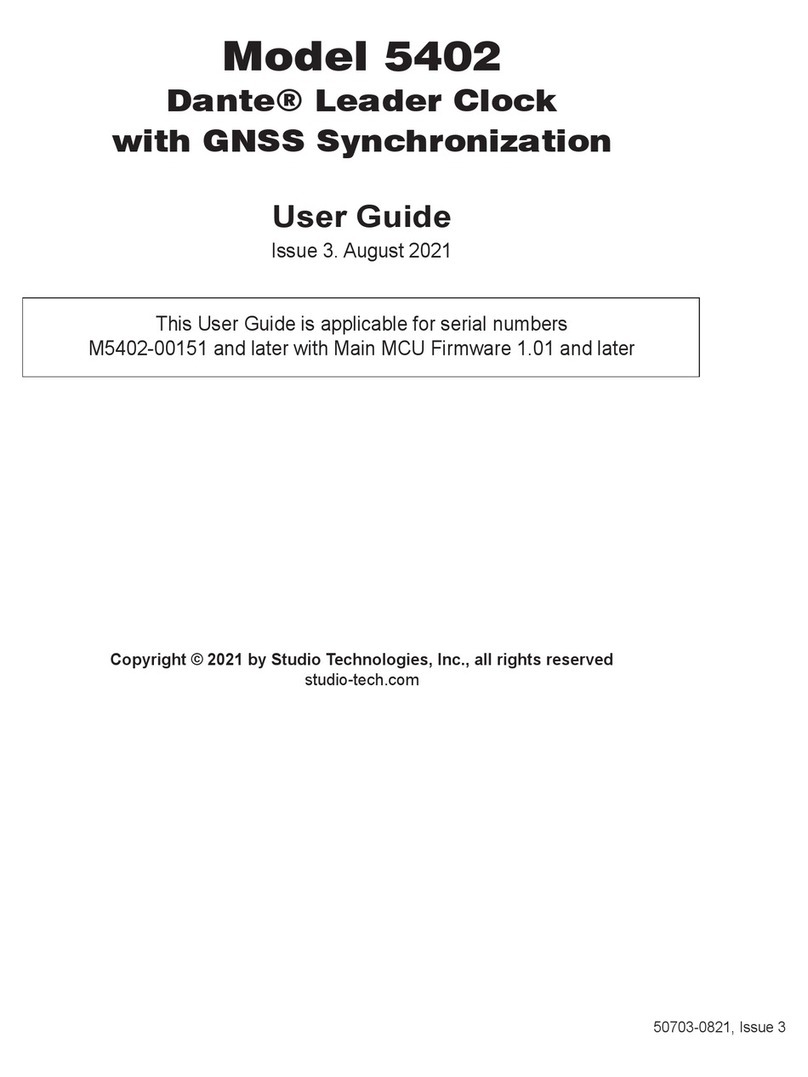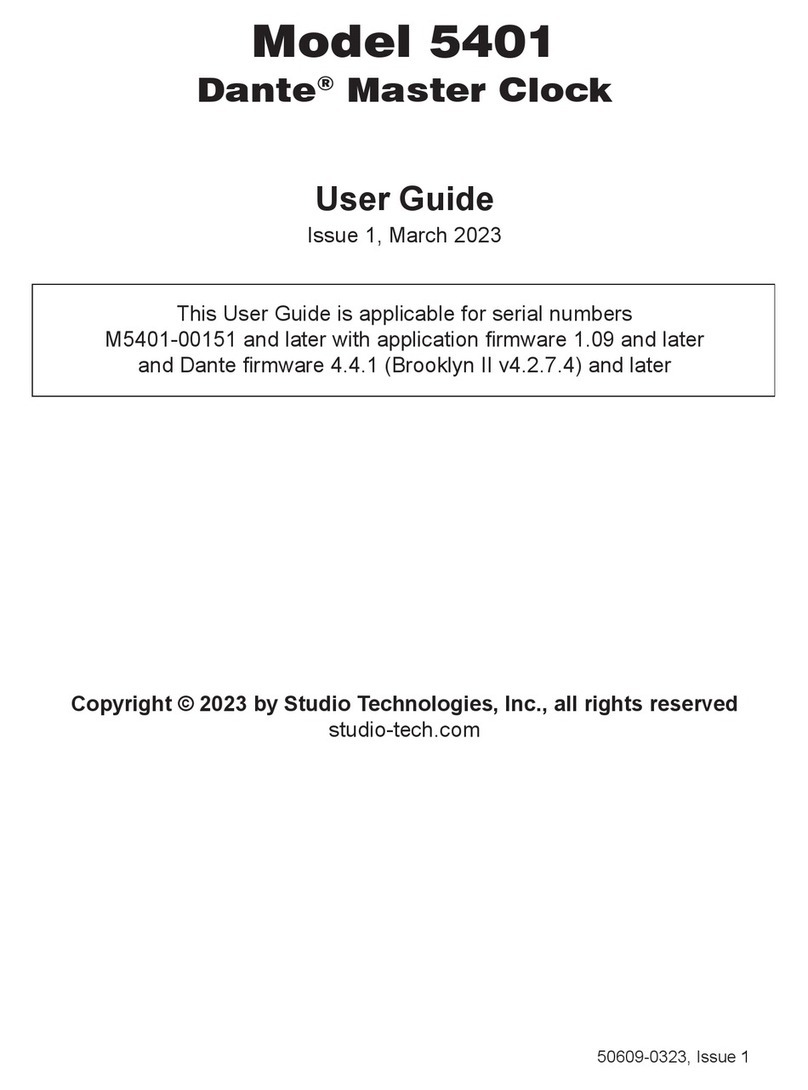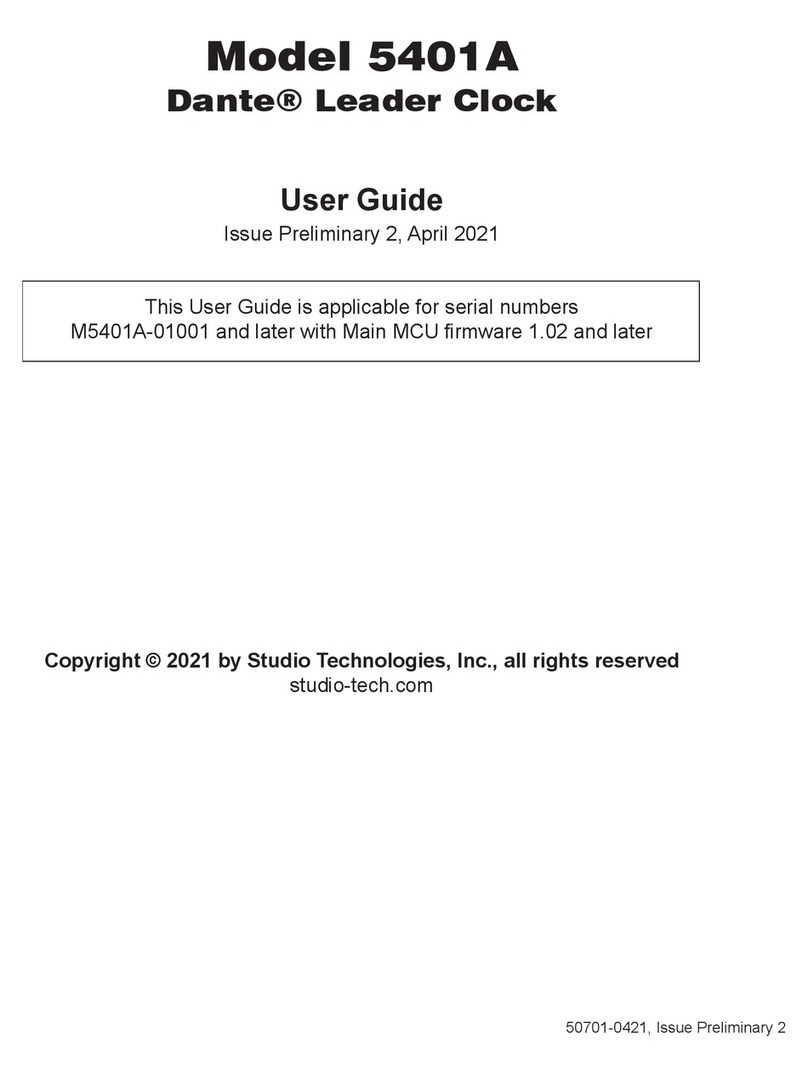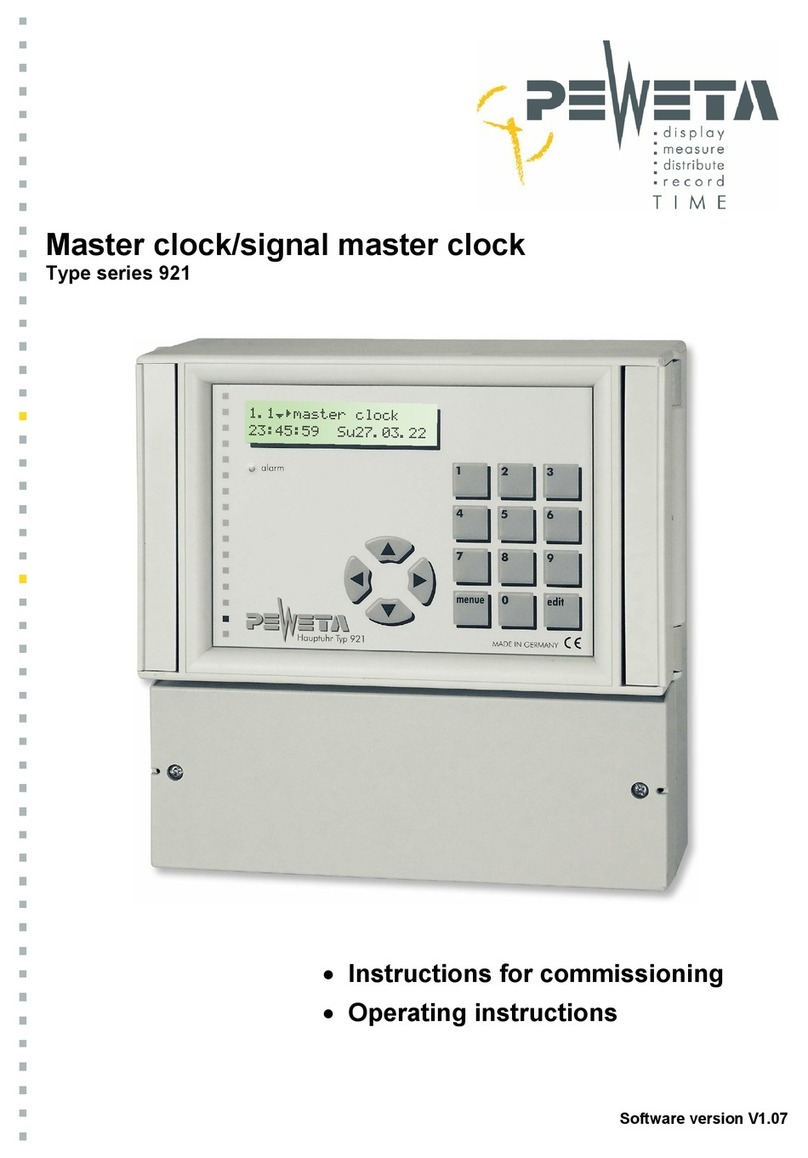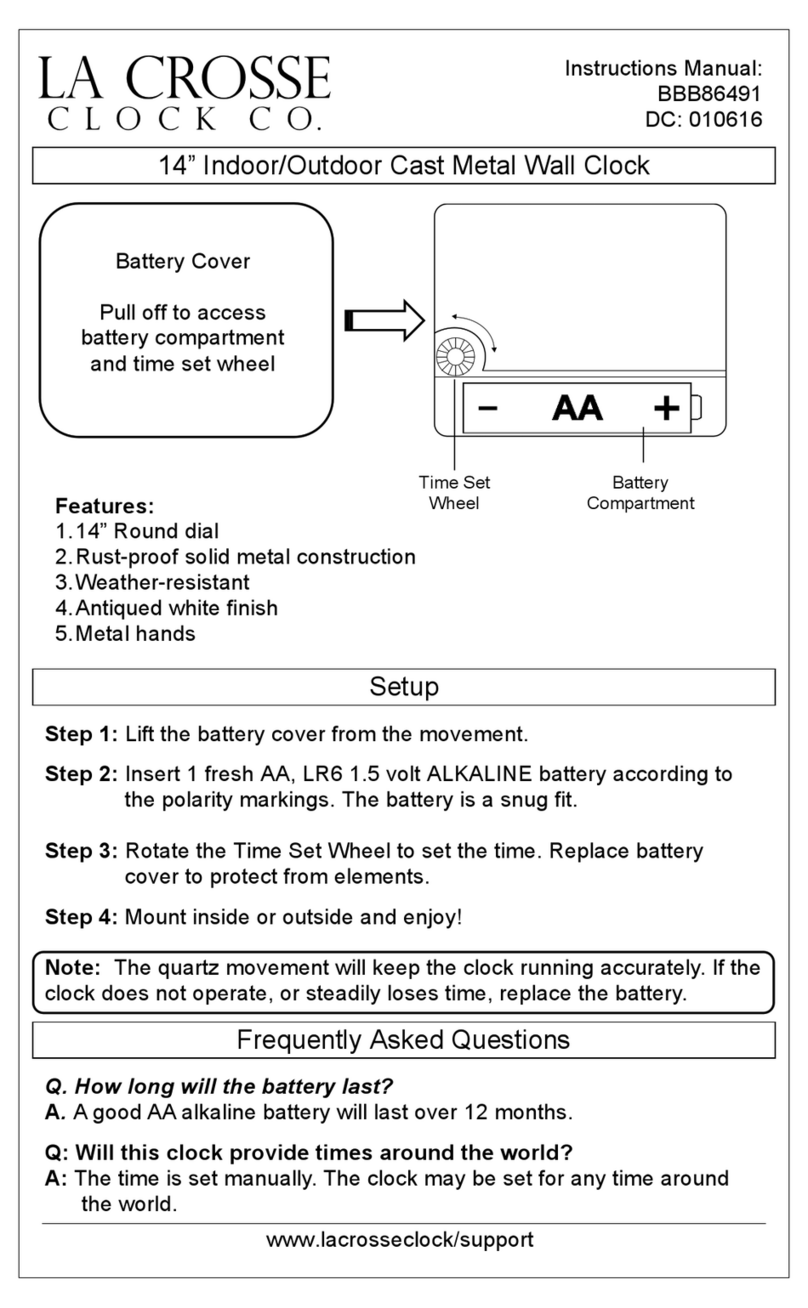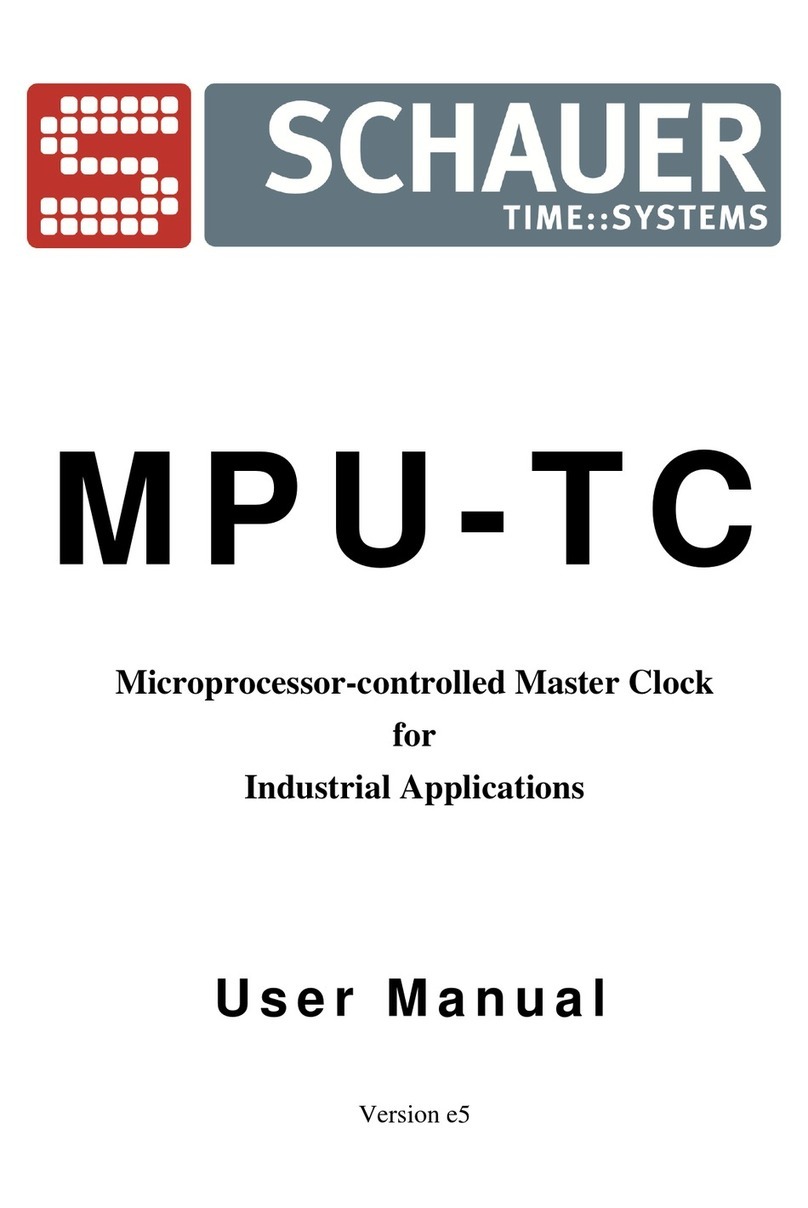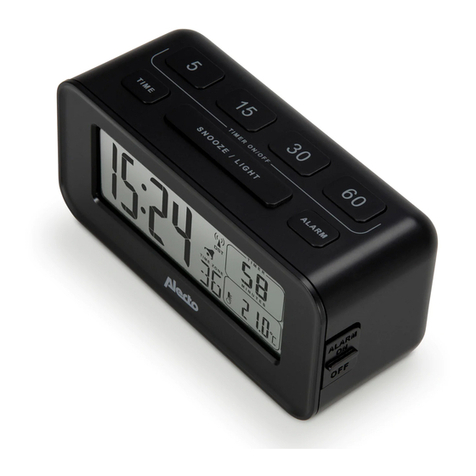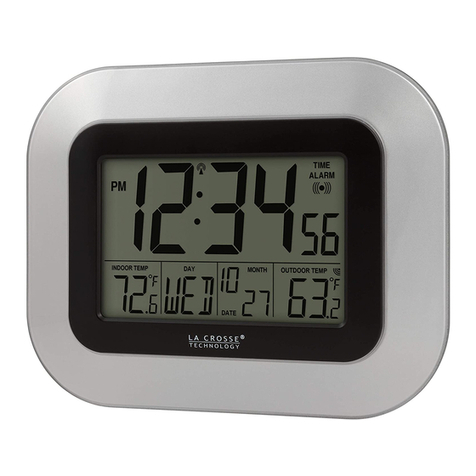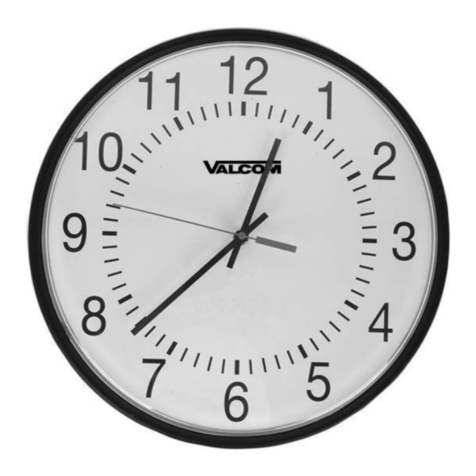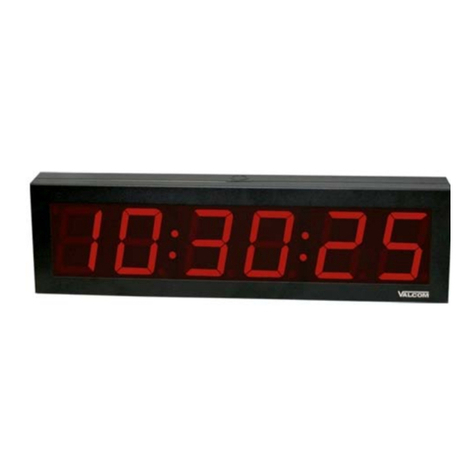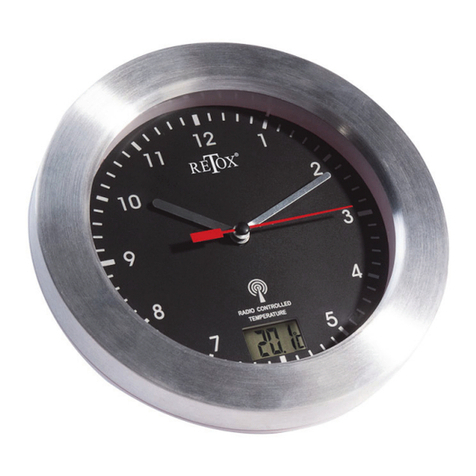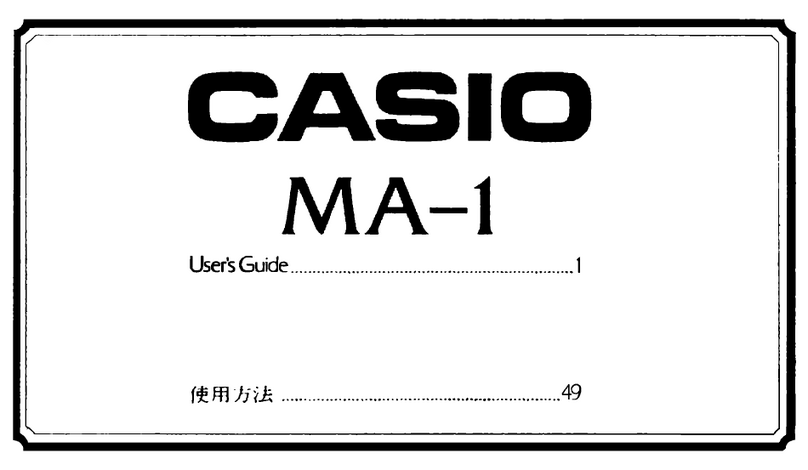Studio Technologies 5402 User manual

50703-0421, Issue Preliminary 1
Copyright © 2021 by Studio Technologies, Inc., all rights reserved
studio-tech.com
User Guide
Issue Preliminary 1, April 2021
This User Guide is applicable for serial numbers
M5402-00151 and later with Main MCU firmware 1.00 and later
Model 5402
Dante® Leader Clock
with GNSS Synchronization

This page intentionally left blank.

Model 5402 User Guide Issue Preliminary 1, April 2021
Studio Technologies, Inc. Page 3
Table of Contents
Revision History .................................................................................................................. 4
Introduction .......................................................................................................................... 5
Installation ........................................................................................................................... 9
Dante Configuration ............................................................................................................ 14
Model 5402 Configuration ................................................................................................... 17
Operation ............................................................................................................................. 36
Technical Notes ................................................................................................................... 48
Specifications ...................................................................................................................... 54
Appendix A–Sync Input Sources ......................................................................................... 56
Appendix B–Network Configuration Examples .................................................................... 57
Appendix C–Dante Controller Network Default Configuration Values ................................. 60
Appendix D–Menu Structure ............................................................................................... 61
Appendix E–Screen Captures ............................................................................................. 62
Appendix F–Model 5402’s Default Configuration Values .................................................... 67
Appendix G–PTPv2 (IEEE® 1588-2008) Default Characteristics ....................................... 68
Appendix H–Accessing the Unit when the User Name and/or Password is Not Known ..... 69

Issue Preliminary 1, April 2021 Model 5402 User Guide
Page 4 Studio Technologies, Inc.
Revision History
Issue Preliminary 1, April 2021:
• Initial preliminary release.

Model 5402 User Guide Issue Preliminary 1, April 2021
Studio Technologies, Inc. Page 5
Introduction
The Model 5402 Dante Leader Clock with
GNSS Synchronization provides precise
timing signals for applications that utilize the
Dante audio-over-IP (AoIP) media network-
ing technology. The unit implements a high-
performance IEEE® 1588 precision time
protocol (PTP) server, compatible with the
requirements of Dante and capable of simul-
taneously supporting the timing needs of up
to hundreds of Dante-compatible devices.
As expected, the Model 5402 provides the
PTPv1 (IEEE 1588-2002) compatibility that’s
required by Dante. In addition, the unit sup-
ports PTPv2 (IEEE 1588-2008) for AES67
applications. The unit includes an integrated
GNSS (satellite) receiver to allow a precise
timing reference to be acquired from the four
major constellations: GPS, Galileo, BeiDou,
and GLONASS. In additional, a sync input
connection allows the Model 5402’s internal
oscillator to be synchronized with a variety of
external timing and reference signals. A word
clock output provides a general-purpose tim-
ing reference for use by external devices.
The Model 5402 integrates with the Dante
Domain Manager™ (DDM) software appli-
cation. With DDM, support for ST 2110 and
AES67 can take place alongside Dante audio.
And with multiple Model 5402 units all utilizing
GNSS-based timing, studios across town or
even around the globe can share audio.
As an additional resource, the Model 5402
generates eight sine-wave audio tones on
Dante transmitter (output) channels. These
can be useful during audio and data network
installation, maintenance, and operation.
The Model 5402 is suitable for use in fixed
and mobile broadcast facilities, post-produc-
tion studios, commercial and educational
theater environments, and entertainment
applications. Only power, a GNSS antenna,
and one, two, or three Ethernet network con-
nections are required for full operation. Us-
ing Dante’s inherent capabilities two Model
5402 units can serve in primary and backup
Leader clock roles for redundant operation.
The unit’s three Gigabit Ethernet (GigE)
network interfaces can be configured for
use in a range of network implementations.
For high-reliability audio applications two of
the interfaces can support redundant Dante
operation while the third can be used for ac-
cessing the management webpages.
An integrated web server allows fast and
flexible monitoring and configuration of the
unit’s networking, clocking, and Dante per-
formance. Front-panel LED indicators, an
LCD display, and pushbutton switches pro-
vide users with direct access to key operat-
ing parameters.
The Model 5402 can be powered by 100-
240 V, 50/60 Hz mains or a source of
12 volts DC. Both can be simultaneously
Figure 1. Model 5402 Dante Leader Clock with GNSS Synchronization front and back views

Issue Preliminary 1, April 2021 Model 5402 User Guide
Page 6 Studio Technologies, Inc.
connected to provide redundant operation.
The lightweight enclosure mounts in one
space (1U) of a 19-inch equipment rack.
Industry-standard connectors are used for
Ethernet, GNSS antenna, DC power, and AC
mains interconnections. Updating the Model
5402’s operating software can be easily per-
formed using a USB flash drive.
Applications
Applications for the Model 5402 include
broadcast and post-production facilities,
college and university audio networks,
arenas, stadiums, corporate installations,
and virtually any application where substan-
tial numbers of Dante-compatible devices
are utilized. The Model 5402 will serve as a
stable and consistent Leader clock for the
entire Dante “network.” And, as expected,
the Model 5402 is compatible with all Dante
devices, no matter what their function or
whom their manufacturer. Applications
that utilize devices compatible with AES67
will also benefit from the Model 5402’s
resources. With its ability to “lock” to a
satellite-based time standard, multiple Model
5402 units can be deployed literally “around
the world” and maintain synchronized PTP
performance.
Why a Dedicated Dante Leader
Clock?
With Dante ubiquitous in fixed and mobile
facilities of all sizes and types, the need
arose for a cost-effective, purpose-designed,
dedicated Leader clock. While an inherent
strength of Dante networking is its carefully
implemented use of the IEEE 1588 stan-
dard to ensure that all connected devices
maintain a common timing reference, the
actual performance can vary widely de-
pending on the specific Dante devices in
use and the overall number of devices on a
network. There are many Dante-compatible
devices that can provide adequate basic
performance as a Leader clock, but with the
Model 5402 networked audio systems get
the benefits of a high-performance Primary
Leader Clock, along with additional unique
capabilities. The unit’s feature set, along
with the associated internal hardware and
software, was designed to provide optimum
performance, flexibility, and system integrity.
Timing Sources
The Model 5402 can provide excellent
Leader clock performance using a timing
reference that is based on signals provided
by one or more GNSS (satellite) constella-
tions. This will ensure accuracy and stabil-
ity that exceeds the capability of standard
Dante devices by at least an order of mag-
nitude. A configuration choice is provided in
a Model 5402 webpage to allow a failover
source of timing to be selected should a
valid GNSS signal become unavailable.
The Model 5402 will also provide strong
Leader clock performance using its temper-
ature-stabilized internal oscillator. While its
standalone performance is excellent, it can
also be “locked” to a variety of external sig-
nals for integration into facilities that already
include a central or main timing reference.
Compatible signals include word clock,
video reference, and 10 MHz. Word clock
is a square wave signal that is often used
as a timing reference in audio-only facilities.
Video reference (“sync”) signals are found
in most broadcast and post-production facili-
ties. The Model 5402 supports the most-
common video format/rate combinations
including “black burst,” bi- and tri-level HD,
and several that are specifically intended for
4K applications. Industrial and commercial
facilities often utilize a source of 10 MHz
sine-wave as a timing reference.

Model 5402 User Guide Issue Preliminary 1, April 2021
Studio Technologies, Inc. Page 7
GNSS Support
The Model 5402’s internal time base can
be synchronized to signals received from
satellite-based timing systems. Most often
referred to as “GPS,” satellite-based time
and position data is more properly identi-
fied as being received from a GNSS (Global
Navigation Satellite System). GPS (Global
Positioning System) is just one set of sat-
ellites that can provide GNSS data. For
maximum flexibility the Model 5402 contains
an integral receiver that is compatible with
the four major worldwide GNSS constella-
tions: GPS (USA), Galileo (Europe), BeiDou
(China), and GLONASS (Russia). In addi-
tion, the unit allows augmentation support
for GPS as provided by QZSS (Japan).
Configuration choices allow which constel-
lations will be utilized by the Model 5402.
This can range from one to all four constel-
lations. Using these capabilities, the Model
5402 can achieve single-digit nanosecond
timing accuracy. Multiple, geographically
disbursed sites (“network nodes”) can each
use a Model 5402 to easily achieve a coor-
dinated timing reference.
For general-purpose use the Model 5402’s
GNSS receiver will also report, by way of
the front-panel display and/or the manage-
ment webpages, the current date and time
of day, as well as longitude and latitude
parameters. In addition, the number of
satellites currently “fixed” (locked) and the
receiver input power can also be observed.
An active, multi-band, high-precision an-
tenna is included with each Model 5402.
The compact antenna is weather-resistant
and includes a 5-meter (16.3 foot) cable
with attached SMA plug. The antenna can
be secured to the selected location using
two machine screws or affixed magnetically
to a metallic surface. Its performance is very
good and many applications will find this
antenna to be sufficient. But it’s expected
that alternate, installer-provided antennas
may also be utilized to meet the specific
needs of various applications. This may
involve supporting longer interface cables,
using different mounting methods, or provid-
ing more-advanced weather-resistant
properties.
Word Clock Output
The Model 5402 generates a precise word
clock output signal that can be used as a
timing reference for related equipment. It’s
specifically intended for “locking” digital
audio devices in applications that use the
Model 5402 to provide timing reference
signals for the associated Dante equipment.
In this way, all devices in an installation will
share a common timing reference.
The word clock output rate can be selected
to be 44.1, 48, 88.2, or 96 kHz. The under-
lying timing source for the word clock out-
put is derived from the Model 5402’s main
timing source. This will typically be one or
more of the supported GNSS constellations.
The main timing source is divided and pro-
cessed by the Model 5402’s logic circuitry to
create the highly stable word clock output.
This ensures that the word clock output is
synchronized with the unit’s PTPv1 and
PTPv2 server functionality.
Figure 2. An active, multi-band, high-precision
antenna is included with each Model 5402

Issue Preliminary 1, April 2021 Model 5402 User Guide
Page 8 Studio Technologies, Inc.
Audio Reference Signals
The Model 5402 generates eight sine-wave
audio reference signals intended for general-
purpose use. These audio tones are pro-
vided by the Model 5402 in the form of Dante
transmitter (output) channels. They can be
connected, using the Dante Controller appli-
cation, to Dante receivers (inputs) on related
equipment. The flexibility of being able to
interconnect signals (create Dante “sub-
scriptions”) between all Dante devices on a
network allows the audio reference tones to
be used for a variety of purposes. Configura-
tion choices allow the frequency and level
of each sine-wave signal to be optimized for
use in specific applications.
Leader Clock Support for
Dante Networks
A core part of the technology underlying
Dante audio-over-IP networking ensures
that all connected devices follow a common
timing reference. This is accomplished us-
ing the IEEE 1588-2002 (PTPv1) and 1588-
2008 (PTPv2) precision time protocols. Any
connected Dante device can be used as a
Leader clock; there is no requirement that a
dedicated Leader clock device be utilized to
realize adequate functionality. However, the
actual performance can vary widely depend-
ing on the specific Dante devices available
and the overall number of Dante devices on
a network.
Many Dante devices utilize the 2- or 4-
channel Ultimo™ ULT or UXT integrated
circuits to implement Dante connectivity.
While Ultimo devices will fully support Dante
audio transport, they are not well suited
to serve as a Leader clock. Ultimo’s PTP
performance is limited and does not have the
ability to synchronize with an external timing
reference. Other Dante devices may use the
Brooklyn II module or Broadway integrated
circuit to support Dante connectivity. In some
cases, these devices can provide good basic
performance as a Leader clock.
However, problems and limitations may arise
when these devices are called upon to per-
form “double duty,” serving in both a primary
function (such as analog-to-Dante interfacing
or audio signal processing) as well as acting
as a Leader clock. This is understandable
as the main purpose of these devices is to
serve functions other than acting as a pri-
mary synchronization reference. Specialized
features, such as allowing a GNSS-derived
time base is rarely, if ever, supported. And
PTP performance can degrade when the
computing power of a device is intended pri-
marily for handling and manipulating digital
audio signals. This can lead to the required
PTP resources being in short supply when
the number of Dante devices that need
timing messages moves into the hundreds.
Also, firmware updates, cabling changes,
and other maintenance tasks typically asso-
ciated with a general-purpose Dante device
would impact the Leader clock functionality
for an entire installation.
The Model 5402 was specifically designed
to support a Dante-based audio or video
system’s Leader clock requirement. And by
utilizing GNSS, multiple Model 5402 units
can be installed at independent locations
while sharing a common timing reference.
The unit’s generation of audio tones and
implementation of the word clock output uti-
lize hardware circuitry that is separate from
that associated with its PTP functionality.
As such, this secondary functionality will not
interfere with PTP operation. Unlike general-
purpose Dante devices, once mounted in an
equipment rack and the required intercon-
nections made, the Model 5402 will perform
its tasks without risk of interruption due to
conflicting resource demands.

Model 5402 User Guide Issue Preliminary 1, April 2021
Studio Technologies, Inc. Page 9
Flexible Networking Capability
Using the Dante Controller application
program, the Model 5402’s three Ether-
net ports can be selected to operate in
one of four modes: Switched, Redundant,
Switched+Mgmt, and Redundant+Mgmt.
This should allow virtually any desired
networking implementation to be easily
achieved.
By using the Switched or Redundant net-
work modes, separate network connections
will be maintained for Dante audio and man-
agement purposes.
In the Switched mode a single Ethernet
connection to either of the Model 5402’s
two Dante Ethernet ports will provide Dante
Leader clock functionality. The remaining
Dante Ethernet port will provide Dante net-
work “loop-through” capability and can be
used to interface with another piece of Eth-
ernet-connected equipment. The manage-
ment Ethernet port will be used to access
the Model 5402’s monitoring and configura-
tion webpages.
In the Redundant mode two independent
Ethernet connections are made to the
Model 5402’s two Dante Ethernet ports,
enabling Dante’s redundant networking
capability. Again, the management Ethernet
port will be used to access the Model 5402’s
monitoring and configuration webpages.
In the Switched+Mgmt mode a single Ether-
net connection is used for both Dante Lead-
er clock functionality as well as providing
access to the Model 5402’s management
webpages. The remaining Dante Ethernet
port will provide network “loop-through”
capability and can be used to interface
with another piece of Ethernet-connected
equipment.
In the Redundant+Mgmt mode two indepen-
dent Ethernet connections can be made to
the Model 5402’s two Dante Ethernet ports.
This will enable Leader clock capability for
redundant Dante applications. Access to the
Model 5402’s management webpages will
be made by way of the Ethernet connection
made to the Dante primary Ethernet port.
Operating Power
The Model 5402 allows an AC mains source
of 100-240 V, 50/60 Hz to be directly con-
nected. It can also be DC powered using
a 10-18 volt source that is connected via a
broadcast-standard 4-pin XLR connector.
If both AC and DC power sources are con-
nected the unit will be powered by the AC
mains supply. Only if the AC mains source
fails will appreciable power be drawn from
the DC source. This allows a source of DC,
typically an external power supply, to serve
in a backup capacity. With this arrangement
normal operation can continue even if AC
mains power is lost.
Future Capabilities
The Model 5402 was designed so that its
capabilities can be enhanced in the future.
A USB connector, located on the unit’s back
panel, allows the three firmware files (em-
bedded software) to be updated using a
USB flash drive. The Model 5402’s Dante
firmware can be updated using one of the
unit’s Ethernet connections, helping to en-
sure that the Dante capabilities remain up to
date. All software files and configuration pa-
rameters are stored in non-volatile memory.
Installation
In this section the Model 5402 will be
mounted in one space (1U) of an equipment
rack. In most cases, a GNSS (satellite)
antenna will be connected. It’s also possible

Issue Preliminary 1, April 2021 Model 5402 User Guide
Page 10 Studio Technologies, Inc.
that an external synchronization source will
be connected. A connection may be made to
the word clock output. One or more Ethernet
data connections will be made. AC mains
and/or DC power will be connected to the
Model 5402.
The interface cable associated with the
included GNSS antenna will be connected to
the SMA jack on the back panel of the Model
5402. Using a coaxial cable terminated with
a BNC plug, an external source of synchro-
nization may be connected to the sync input.
A word clock output is provided by way of a
BNC jack and may be utilized by one or more
pieces of equipment. Up to three Ethernet
data connections will be made to the Model
5402 using standard RJ45 patch cables.
AC mains power can be connected to the
Model 5402 by means of a detachable cord
that is compatible with the unit’s 3-pin IEC
320 C14 inlet connector. Some applications
may warrant connection to a source of nomi-
nal 12 volts DC which can be made by way
of a 4-pin XLR connector. A DC source can
be used to power the Model 5402 as well as
serving as a backup power source should AC
mains not be present.
What’s Included
The shipping carton contains a Model 5402
Dante Leader Clock, a GNSS antenna, and
instructions on how to obtain an electronic
copy of this guide. Also included in the ship-
ping carton is a North-American-standard
AC mains cord. For destinations outside of
North America the local reseller or distribu-
tor should provide an appropriate AC mains
cord.
Mounting the Model 5402
The Model 5402 Dante Leader Clock re-
quires one space (1U) in a standard 19-inch
(48.3 cm) equipment rack. Secure the unit
into the designated equipment rack using
two mounting screws per side. As the Model
5402 does not contain a fan or other noise-
producing source it can be located within
a room or other structure where audio moni-
toring is going to take place. But the priority
when selecting a location is to ensure that
the cable associated with the GNSS an-
tenna can reach the SMA jack on the Model
5402’s back panel. In addition, some or all
of the connections involving the sync input
jack, the word clock output jack, the Ether-
net interface RJ45 jacks, and the AC mains
and/or DC power connectors may be utilized.
The included GNSS antenna has an integral
5-meter (16.3 foot) nominal cable terminated
with an SMA plug. It’s possible that an
extension cable or alternate antenna will
be utilized which could expand the mount-
ing location choices. Twisted-pair (UTC)
Ethernet has a 100-meter (325-foot) inter-
connection cable limitation. But that can be
overcome by using fiber-optic interconnec-
tions between the Model 5402 and the Eth-
ernet switch or switches in the one or more
associated local-area-networks (LANs).
Connecting the GNSS Antenna
A multiband GNSS antenna is included with
each Model 5402. This is not just a common
low-cost single-band generic “GPS” antenna.
This antenna, Studio Technologies’ order
code ANT-GNSS-01, is a premium-quality
device that will support reception of all the
satellite constellations that can be received
by the Model 5402. The antenna must be
located where an unobstructed “view” of
the sky is available. The top of the antenna
should face up so as to be within line-of-sight
of overhead satellites. In most cases, an out-
door location will be optimal but selecting an
indoor location that has minimal RF blockage
can also be effectively used. The antenna
is suitable for outdoor use and has an IP67

Model 5402 User Guide Issue Preliminary 1, April 2021
Studio Technologies, Inc. Page 11
rating. This prevents dust from entering the
unit. It also provides moisture protection, but
the antenna should not be left submerged
in water. It’s possible that the antenna will
work from inside a building, such as next
to a window or beneath a skylight, but with
reduced performance.
The antenna has an integral magnet such
that it can self-affix to a ferrous surface. It
also has two mounting holes, 68 millimeters
apart center-to-center, that are optimized for
use with M4 or number 8 screws. The an-
tenna includes a 5-meter (16.3-foot) nomi-
nal length of miniature RG174 (50 ohm)
coaxial cable terminated with an SMA plug.
The plug must be securely affixed to the
SMA jack on the Model 5402’s back panel.
The cable must not be crushed and sharp
bends must be avoided. Do not secure the
cable using cable ties such that the cable’s
mechanical characteristics are changed.
It’s possible that the antenna’s cable can be
extended using a low-loss, 50-ohm nominal
coaxial cable jumper assembly. These are
commercially available from a variety of
sources. The exact characteristics of an ex-
tension cable are difficult to define, however
minimizing signal loss is critical. Testing the
Model 5402 for proper GNSS reception with
the antenna and proposed cable extender in
place is really the only certain way of ensur-
ing acceptable operation.
The Model 5402 can support the use of
other multiband GNSS antennas. Studio
Technologies has tested several other an-
tennas and they performed very well. Refer
to the Technical Notes section of this guide
for details.
Sync Input
An external synchronization source can be
connected to the Model 5402’s sync input
BNC jack. Located on the back panel, this
input allows the Model 5402’s internal tim-
ing to be “locked” to an external reference.
In most cases, utilizing the sync input won’t
be necessary as the unit’s GNSS receiver
will typically provide an equal or better timing
reference.
Signals that are compatible with the Model
5402’s sync input include word clock, bi-level
video, tri-level video, and 10 MHz sine-wave.
A configuration setting in the Sync Input
webpage defines what type of signal is going
to be connected. Another setting defines if a
termination impedance is applied to the sync
input. Refer to the Specifications section of
this guide for the general characteristics re-
quired of acceptable external sync signals.
A connected word clock signal must be a
square wave with a rate that matches the
Dante sample rate as defined in the Dante
Controller application. The rate can be 44.1,
48, 88.2, or 96 kHz. If termination has been
enabled for the sync input when it has been
configured for word clock an impedance of
75 ohms will be applied.
A source of bi-level or tri-level video can also
be connected to the sync input. Circuitry
within the Model 5402 will decode many of
the common video rates and formats, al-
lowing them to serve as a timing reference.
Refer to Appendix A, located at the end of
this guide, for a list of compatible rates and
formats. If the sync input is configured for
video and termination has been enabled an
impedance of 75 ohms will be applied.
A source of 10 MHz sine-wave can be con-
nected to the Model 5402’s sync input. This
type of signal is commonly used as a timing
reference in industrial and instrumentation
applications. An impedance of 50 ohms will
be applied to the sync input if termination
has been enabled and the source is selected
for 10 MHz.

Issue Preliminary 1, April 2021 Model 5402 User Guide
Page 12 Studio Technologies, Inc.
Word Clock Output
A word clock output signal is provided for
use by other devices that want to be “timed”
from the Model 5402. Available by way of
a BNC jack located on the back panel, the
square wave output has a frequency
that matches the unit’s configured Dante
sample rate. Choices are 44.1, 48, 88.2,
and 96 kHz. The exact frequency of the
word clock output is based on the timing ref-
erence that has been selected for the Model
5402. If, for example, GNSS was selected
as the unit’s timing reference, then the word
clock output would be “locked” to it.
The source impedance of the word clock
signal is 75 ohms and its unterminated
output level is 5 volts peak-to-peak (Vpp).
When externally terminated with a 75 ohm
load the word clock output level will drop to
2.5 Vpp.
Ethernet Connections
The Model 5402 provides three Gigabit
Ethernet (GigE) ports for flexibility and
compatibility with many networking imple-
mentations. Two ports are provided for
interconnections with one or two local area
networks (LANs) associated with Dante
audio-over-IP networking schemes. They
are labeled as PRI (primary) and SEC
(secondary). The third Ethernet port, labeled
MGMT, can be used to access the Model
5402 management resources. An internal
web server function supports the Model
5402’s management port’s webpages.
These webpages are used for configuration,
monitoring, and maintenance of Model 5402
operation. Refer to Figure 3 for an overview
of the Model 5402’s three Ethernet ports
and how they can operate.
Using the Dante Controller application,
the three Ethernet ports can be config-
ured to operate in one of four modes:
Switched, Redundant, Switched+Mgmt, or
Redundant+Mgmt. If configured for either
the Switched or Redundant modes the man-
agement webpages are accessed by way
of the management Ethernet port. When
configured for the Switched+Mgmt mode
the management webpages are accessed
by way of either the primary or second-
ary Ethernet port. When configured for the
Redundant+Mgmt mode the management
webpages are accessed using an Ethernet
connection made to the primary Ethernet
port.
By providing three Ethernet ports and four
configuration modes, the Model 5402
allows support for virtually all facilities, in-
cluding those that utilize separate networks
for Dante audio transport and equipment
management. In this way, “production” net-
works that support transport of audio signals
by way of a single LAN (Switched mode) or
two LANs (Redundant mode) can be sepa-
rate from an engineering network that is
used by technical personnel for configuring
and maintaining a facility or “plant.”
Dante Controller Network Model 5402 Ethernet Port
Switch Configuration Pri Sec Mgmt
Switched Dante Management
Redundant Dante Primary Dante Secondary Management
Switched+Mgmt Dante and Management Disabled
Redundant+Mgmt Dante Primary and Management Dante Secondary Disabled
Figure 3. Model 5402 Ethernet Port Configuration and Operation

Model 5402 User Guide Issue Preliminary 1, April 2021
Studio Technologies, Inc. Page 13
Connections to the three Ethernet interfaces
are made by way of standard RJ45 jacks that
are located on the back of the Model 5402’s
enclosure. The Ethernet interfaces support
auto MDI/MDI-X so that crossover cables
are not required. Refer to Appendix B, locat-
ed at the end of this guide, for examples
of how the Model 5402’s three Ethernet inter-
faces might be utilized. It’s difficult to con-
ceive of a network environment that the unit
wouldn’t be able to effectively support.
Dante Port Connections
At least one 1000BASE-T (GigE) Ethernet
connection is required for Model 5402 Dante
operation. It should be connected to the
primary RJ45 jack. A second 1000BASE-T
(GigE) connection can be made to the sec-
ondary RJ45 jack if Redundant Dante is
desired. For this functionality to be active the
Model 5402’s network configuration must be
set for the Redundant or Redundant+Mgmt
mode within the Dante Controller software
application. While technically 100BASE-TX
(100 Mb/s) Ethernet can also be used for
these Dante connections, it is not optimal.
Additionally, it’s important to note that
10BASE-T (10 Mb/s) Ethernet connections
are not sufficient.
When configured in Dante Controller for
the Switched or Switched+Mgmt modes the
Model 5402’s Dante secondary Ethernet con-
nection can also be used as a “loop through”
port such as would be provided by an Eth-
ernet switch. Switched mode is the default
setting but using the Dante secondary port
in this manner for applications other than
troubleshooting or “looping” to access the
Model 5402’s management port is not rec-
ommended. It will function reliably but “daisy
chaining” Ethernet signals can limit flexibility
and present a failure point; it’s optimal if each
Dante Ethernet interface connects directly to
a separate port on an Ethernet switch.
Management Port Connection
If required by the needs of an application,
the management webpages can be ac-
cessed using an Ethernet signal connected
to the Model 5402’s management Ethernet
port. This requires that the network mode in
Dante Controller be configured for Switched
or Redundant. It’s recommended that a
1000BASE-T (GigE) connection be made
but a 100BASE-TX (100 Mb/s) connection is
sufficient. (GigE will provide the best perfor-
mance and it’s assumed that all contempo-
rary applications will support it.)
Access to the Model 5402’s management
webpages can also be obtained using the
same network connection or connections
that are being used for Dante audio. This
requires that the network mode in Dante
Controller be configured for Switched+Mgmt
or Redundant+Mgmt. Appendix B provides
example of how these network scenarios
can easily be implemented.
Connecting Power
The Model 5402 requires a source of AC
mains or nominal 12 volts DC for operation.
Either source can be connected with the
same result. Both can also be simultane-
ously connected if a redundant (backup)
power scheme is desired.
Connecting AC Mains Power
The Model 5402 can operate directly from
AC mains power of 100 to 240 volts, 50/60
Hz, 5 watts maximum. As a “universal mains
input” device there are no switches to set or
jumpers to install. A 3-pin IEC 320 C14 inlet
connector on the back panel mates with a
detachable mains cord set.
All units are supplied from the factory with
an AC mains cord that has a North-Ameri-
can (NEMA 5-15L) standard plug on one
end and an IEC 320 C13 connector on the

Issue Preliminary 1, April 2021 Model 5402 User Guide
Page 14 Studio Technologies, Inc.
other end. Units intended for use in other
destinations require that an appropriate
mains cord be obtained. The wire colors in
the mains cord should conform to the in-
ternationally recognized color code and be
terminated accordingly:
Connection Wire Color
Neutral (N) Light Blue
Line (L) Brown
Earth/Ground (E) Green/Yellow
Because the Model 5402 does not contain a
power on/off switch it will begin operation as
soon as AC mains power is connected.
Safety Warning: The Model 5402 does
not contain an AC mains disconnect
switch. As such, the AC mains cord plug
serves as the disconnection device. Safe-
ty considerations require that the plug
and associated inlet be easily accessible
to allow rapid disconnection of AC mains
power should it prove necessary.
Connecting DC Power
The Model 5402 can also operate from a
source of 10 to 18 volts DC. The current
required from a 12 volts DC source is 0.5
ampere (500 milliamperes) maximum. A
4-pin male XLR connector, located on the
unit’s back panel, is used to connect the
source of DC. Prepare a mating connec-
tor (female) so that pin 1 is DC– and pin
4 is DC+. Pins 2 and 3 are not used and
should remain unconnected. This connector
type and pinout have become a broadcast
DC power standard and should be familiar
to many technical personnel. Because the
Model 5402 contains no power on/off switch
it will begin operation as soon as a DC power
source is connected.
As previously mentioned, both an AC mains
source and a DC source can be connected
at the same time. If this is the implementa-
tion then the AC mains source will always
power the Model 5402 with the DC source
serving as a “hot standby.” Only if the AC
source fails will the unit draw power from
the DC source. This will occur automatically
with no interruption of Model 5402 operation.
In this “standby” mode (when an AC mains
source is connected) the Model 5402 draws
less than 110 microamperes (uA) from a 12
volts DC input.
Dante Configuration
For audio and timing to correctly pass from
the Model 5402 requires that several Dante-
related parameters be configured. These
configuration settings are stored in non-
volatile memory within the Model 5402’s
Dante network interface circuitry. Configu-
ration will typically be done with the Dante
Controller software application, available for
download free of charge at audinate.com.
Refer to Appendix C of the list of the Model
5402’s Dante Controller default configura-
tion. Versions of Dante Controller are avail-
able to support several operating systems.
The Model 5402’s Dante interface is com-
patible with the Dante Domain Manager
(DDM) software application. Refer to DDM
documentation, also available from Audinate,
for details on which Model 5402 and related
parameters may have to be configured.
Audio Routing
The Model 5402’s eight Dante transmitter
(output) channels can be assigned to the
desired Dante receiver (input) channels on
associated equipment. This will route the
eight channels associated with the tone
generator function. Within Dante Controller
a “subscription” is the term used for routing
a transmitter flow (a group of output chan-
nels) to a receiver flow (a group of input
channels).

Model 5402 User Guide Issue Preliminary 1, April 2021
Studio Technologies, Inc. Page 15
The Model 5402 uses a Brooklyn II module
to implement its Dante functionality. The
number of transmitter flows associated with
this module is 32 and, as such, typically no
flow limitation should occur. These flows
can either be unicast, multicast, or a combi-
nation of the two. Note, however, that when
AES67 mode is enabled in Dante Controller
the Dante transmitter (output) channels
will only function in multicast; unicast is
not supported.
Unit and Channel Names
The Model 5402 has a default Dante
device name of ST-M5402- along with a
unique suffix. The suffix identifies the spe-
cific Model 5402 that is being configured.
The suffix’s actual alpha and/or numeric
characters relate to the MAC address of the
unit’s Brooklyn II module. The eight Dante
transmitter (output) channels have default
names of Tone 1 through Tone 8. Using
Dante Controller, the device and channel
names can be revised as appropriate for
a specific application.
Device Configuration
The Model 5402 supports audio sample
rates of 44.1, 48, 88.2, and 96 kHz with no
pull-up/down options available. The digital
audio data is in the form of 24-bit pulse-
code modulation (PCM 24) samples. Clock-
ing- and latency-related parameters can be
adjusted if required in Dante Controller but
the default values are typically correct.
Network Configuration – Dante
As has been covered previously in this
guide, the Model 5402 allows connection
of one, two, or three Ethernet signals using
standard RJ45 jacks which are located on
the back panel. In many applications two of
the jacks will be used for Dante audio and
the third for connecting to a network desig-
nated for device management purposes. It’s
also possible to access the Model 5402’s
management webpages using the Dante
Ethernet ports. The Model 5402’s Dante
ports are labeled PRI and SEC indicating
that they are typically used for the primary
and secondary connections. The third
Ethernet port is labeled MGMT, indicating
that it is intended for use accessing the
management webpages. How these three
Ethernet ports function can be selected in
the Network Config – Switch Configuration
section of Dante Controller. The choices are
Switched, Redundant, Switched+Mgmt, and
Redundant+Mgmt.
If Switched is selected then the Model 5402
can establish one Dante audio connection
with an Ethernet network. It doesn’t mat-
ter which RJ45 jack is utilized, although for
clarity this would typically be the primary
jack. The secondary RJ45 jack can be
used to interconnect with another piece of
networked equipment. The management
Ethernet port will be used to access the
management webpages.
If the Model 5402’s Dante network is con-
figured for Switched ensure that only one
of the two Dante RJ45 jacks on the back
panel is connected to the LAN associated
with the Dante network. If both of the Model
5402’s Dante RJ45 connections are routed
to ports on the same LAN this will typically
“crash” the network! (Although some of the
latest/most-advanced Ethernet switches
will automatically detect and prevent such a
“network bridging” issue from occurring.)
If Switched+Mgmt is selected the same
issues as discussed in the previous two
paragraphs would again apply. The only dif-
ference is that the management webpages
would be accessed using the same Dante
Ethernet port that is being used to access

Issue Preliminary 1, April 2021 Model 5402 User Guide
Page 16 Studio Technologies, Inc.
the Dante network. The management Ether-
net port will be disabled.
If Redundant is selected then Dante’s Re-
dundant networking capability will be en-
abled. In this case, separate Ethernet LAN
connections should be made to the Dante
primary and Dante secondary RJ45 jacks.
Again, the Model 5402’s separate manage-
ment Ethernet port will be used to access
the management webpages.
If Redundant+Mgmt is selected in Dante
Controller then the network connection made
to the Dante primary Ethernet port will also
be used to access the management web-
pages. The Model 5402’s separate manage-
ment port will be disabled.
IP Addresses
When a Model 5402 has been configured for
either the Switched or Switched+Mgmt net-
work mode a single Dante IP address will be
associated with the network connection that
is made to either the Dante primary or the
Dante secondary RJ45 jack. If the network
configuration has been selected for Redun-
dant or Redundant+Mgmt then separate IP
addresses and related network parameters
will be assigned to the Dante primary and
Dante secondary Ethernet ports. No mat-
ter what network mode has been selected
the Model 5402 will always have a separate
management IP address.
Typically, the Model 5402’s Dante IP address
or addresses and related network param-
eters will be determined automatically using
DHCP or, if that’s not available, the link-
local network protocol. If desired, the Dante
Controller application does allow Dante IP
addresses and related network parameters
to be manually set to a fixed (static) configu-
ration. While this is a more-involved process
than simply letting DHCP or link-local “do
their thing,” if fixed addressing is necessary
then this capability is available.
Note that if the Model 5402’s network con-
figuration has been set for Redundant or
Redundant+Mgmt then the Dante primary
and Dante secondary IP addresses and
related parameters can be independently
configured. This allows both Dante interfaces
to be configured automatically, both interfac-
es to be configured manually, or one inter-
face to be configured automatically and the
other to be configured manually.
By default, the Model 5402’s management IP
address and related network parameters will
be determined automatically using DHCP or
link-local. A configuration option, accessible
using the front-panel display and associated
buttons or the management webpages, al-
lows manual control of the management IP
address, subnet mask, and gateway address
values.
AES67 Configuration – AES67
Mode
Dante Controller allows a Model 5402 to
be configured for AES67 operation. This
requires the AES67 mode to be set for
Enabled. As previously noted in this guide,
if AES67 mode is enabled then PTPv2 will
be utilized and the Dante transmitter (output)
channels will use multicast. The sample rate
will be fixed at 48 kHz.
Preferred Clock Source
By the very nature of its intended application,
the Model 5402 will normally serve as the
Leader Clock for all Dante-enabled devices.
The unit has the ability to communicate with
the Dante network, selecting itself as the
Preferred Leader and causing the Enabled
Sync to External function to be enabled.
The status of these two parameters can be

Model 5402 User Guide Issue Preliminary 1, April 2021
Studio Technologies, Inc. Page 17
observed using the Clock Status function in
Dante Controller.
Settings accessible using the Model 5402’s
management webpages allow extensive
changes to the clock configuration. These are
provided for use when troubleshooting or ad-
dressing special applications. In most cases,
the Model 5402’s default settings would be
appropriate and should be utilized.
Model 5402
Configuration
Many Model 5402 Dante Leader Clock op-
erating parameters can be configured us-
ing the management system’s webpages
that are provided by way of one of the unit’s
Ethernet ports. The specific port utilized for
management will depend on the network
configuration that is selected using the Dante
Controller application. A standard web brows-
er is all that is required to utilize the menu
webpages.
Several key network configuration param-
eters can also be viewed and revised using
the Model 5402’s front-panel graphics display
and associated pushbutton switches. Refer to
Appendix D for details on which parameters
can be revised in this manner.
Management IP Address
It’s easy to identify the Model 5402’s man-
agement IP address by way of the front-panel
display. If the screen saver function is active,
as it will be in most situations, one of the
six pages that will automatically display will
show the current management IP address.
As such, a user can simply observe the se-
quencing menu pages and watch for the one
that displays the current management IP ad-
dress. If it’s desired that the current manage-
ment IP address be continuously displayed
then the Enter pushbutton switch on the
front panel should be pressed. This will stop
the screen saver function and cause the
current management IP address to display.
It will also allow the various menu pages to
be accessed using the up, down, left, and
right pushbutton switches. Simultaneously
pressing the left and right arrow buttons
will cause the screen saver mode to begin
again. The screen saver mode will also
automatically start two minutes after the last
press of any of the front-panel pushbutton
switches.
How the management Ethernet port obtains
its IP address will depend on the manage-
ment interface configuration setting. The
default method is automatic so the Model
5402’s management port will first try to ob-
tain an IP address using DHCP. If that is not
successful an IP address will be assigned
using the link-local protocol. An address of
169.254.x.x will indicate that an IPv4 ad-
dress was established using link-local. The
Model 5402 may also have been configured
to use a manual (fixed or static) IP address.
The front-panel display and associated
pushbuttons, or the Model 5402’s manage-
ment webpages, can be used to review
and/or make changes to the management
IP address and related parameters.
Accessing the Management
Webpages
To access the Model 5402’s home web-
page, type the unit’s management IP ad-
dress into a browser’s search bar. (It’s
possible that some browsers may require
including the text http:// followed by the IP
address.) Of course, the computer associ-
ated with the browser must be on the same
LAN and subnet as the Model 5402.

Issue Preliminary 1, April 2021 Model 5402 User Guide
Page 18 Studio Technologies, Inc.
Home Menu
Once the Model 5402 menu system has
been accessed the Home webpage will ap-
pear. It provides seven display-only fields
along with a link to the Login menu web-
page. The fields are similar to those provid-
ed in the Main menu configuration webpage.
The current clock source field will display
which timing source is actively being uti-
lized by the Model 5402. The GNSS status
field will indicate the current condition of the
Model 5402’s GNSS (satellite) receiver. The
sync input status field displays the current
operating condition of the external sync in-
put whose jack is located on the unit’s back
panel. The four Dante sync status fields
will display the role that the Model 5402 is
actively playing as PTPv1 and PTPv2 tim-
ing resources for the devices connected to
the associated network or networks. Details
about these fields are provided in the Main
menu paragraphs found later in this section.
Login Menu
From the Home webpage click on the Login
tab to access the Login webpage. Entry of
a valid User Name and Password is re-
quired to access the additional configuration
menus. The Model 5402 doesn’t incorporate
a sophisticated security implementation.
The User Name and Password, as well as
the underlying software, is intended to keep
“honest” people from making unauthorized
changes to the configuration of the Model
5402. It is not intended as a sophisticated,
rigorous security system.
Should the applicable User Name and/or
Password be misplaced, refer to the Techni-
cal Notes section and/or Appendix H of this
guide for a recovery method.
User Name
Enter the Model 5402’s User Name into this
field. It is case sensitive. The default User
Name is guest. If both the default User
Name and the default Password are active
then the User Name will display in this field.
Password
Enter the Model 5402’s Password into
this field. It is case sensitive. The default
Password is guest. If both the default User
Name and the default Password are active
then the Password will display in this field.
Log In Button
Click on the Log In button to submit the
entered User Name and Password. If the
correct entries have been made the Main
menu webpage will display. If an incorrect
User Name and/or Password is entered
then a login failed message will be dis-
played.
Main Menu
Once the correct User Name and Password
have been submitted the Main menu web-
page will be displayed. This menu provides
the ability to select three important operating
parameters as well as displaying eight key
real-time conditions. In addition, the menu
system allows direct access to other menu
webpages. Refer to Appendix E for a view of
the Main menu.
Main Clock Source
This is a configurable field with four choices:
Internal, GNSS, Sync Input, or Dante.
This setting determines which source will be
the main (normal) timing source that is used
by the Model 5402’s circuitry as its own
“Leader” timing reference. This is the clock
source that will be used by the Model 5402’s
PTPv1 and PTPv2 servers that are critical to

Model 5402 User Guide Issue Preliminary 1, April 2021
Studio Technologies, Inc. Page 19
the Model 5402’s support of related Dante
devices. When Internal is selected the
Model 5402’s temperature-stabilized, high-
performance crystal oscillator is utilized.
This will provide excellent timing accuracy
and consistent long-term performance. This
source is far superior to that provided by
other standard Dante devices. This is the
correct choice if GNSS is not going to be
utilized or a high-quality external reference
signal is not going to be connected to the
sync input.
When GNSS is selected the timing refer-
ence that is derived from the selected sat-
ellite constellation or constellations will be
used. This would be, assuming that a solid
GNSS “lock” can be established, the most
accurate and consistent timing source. It’s
expected that GNSS will be selected in most
Model 5402 applications.
When Sync Input is selected the Model
5402’s external sync input connection will
be utilized. Using a BNC jack, located on
the Model 5402’s back panel, an external
source of word clock, video reference, or
10 MHz sine-wave can be connected. Cir-
cuitry within the Model 5402 will “lock” (syn-
chronize) the internal timing signals to the
externally provided reference signal.
Selecting Dante will instruct the Model 5402
to use the clock signal provided by its Dante
interface circuitry as its reference timing
source. The Dante interface circuitry will
either use its internal crystal oscillator or
synchronize to another Dante device on the
associated network. The actual clock source
used by the Model 5402’s Dante interface
will depend on a setting in the Dante Con-
troller application.
The Model 5402 includes the choice of
Dante as the main clock source only for
trouble-shooting or other factory-directed
activities. It’s not expected that this selection
will ever be used during normal Model 5402
operation. By selecting Dante the excellent
timing performance that the GNSS receiver,
the external sync input, or the internal oscilla-
tor would not be utilized.
Failover Clock Source
This is a configurable field with two choices:
Internal or Dante.
This configuration choice selects which tim-
ing source will be used should the Model
5402’s selected main clock source become
unavailable. Specifically, the failover source
will be used if a GNSS lock can’t be obtained
or a valid sync source is not connected to
the sync input. If Internal is selected then the
unit’s crystal oscillator will be utilized as the
Leader clock source should a valid GNSS or
sync input signal not be available. If Dante is
selected then the failover source will be the
timing signal derived from the Model 5402’s
Dante interface.
From a performance standpoint it’s prefer-
able to select Internal. This ensures that the
best clock performance can be obtained
should the failover condition be active.
However, selecting Dante would allow an
interesting, albeit obscure, alerting feature
to become active. In the Dante Control-
ler application, a device such as the Model
5402 that has been selected as the Preferred
Leader with an external source allowed will
have an error condition occur if the Model
5402’s Dante interface doesn’t detect an ex-
ternal reference being applied. And losing the
external reference is what the Model 5402’s
circuitry will do should failover be activated
and Dante selected as the failover source.
In this way, a Dante network user could be
alerted to a clocking issue should the Model
5402 lose its important GNSS or external
sync input source.

Issue Preliminary 1, April 2021 Model 5402 User Guide
Page 20 Studio Technologies, Inc.
However, having an error condition reported
in the Dante Controller application is prob-
ably not terribly important. The Dante SYNC
LED, located on the Model 5402’s front
panel, will also offer a clear indication of a
loss of a valid GNSS or external sync input
signal. This LED will typically slowly flash
green when the Model 5402 is functioning
correctly as the Leader clock for the Dante
network. However, should the unit be config-
ured to use GNSS or an external sync input
signal and a valid one is not present, the
SYNC LED will flash orange to indicate this
loss of lock and that the failover source is
in use. In addition, the display will provide a
text indication of this condition.
Force Preferred Leader
This is a configurable field with two choices:
Disabled or Enabled.
This function impacts how the Model 5402
will control a Dante network’s selection of
which device is going to serve as the Leader
clock. As the main reason for the Model
5402’s existence is to serve as a Leader
clock, in most applications the unit should
be serving in that role. By forcing the Model
5402 to be a Preferred Leader clock it helps
to ensure optimal Dante network operation.
By enabling this configuration, users of the
Dante Controller application will not be able
to accidentally disable the Model 5402 as a
Preferred Leader. One can observe exactly
what is meant by the term Force Preferred
Leader by unchecking the Model 5402’s
Preferred Leader check box in Dante Con-
troller. After a short interval the box will au-
tomatically return to the enabled (checked)
state.
How the Model 5402 handles forcing the
Dante network to be a Preferred Leader
clock and, if applicable, automatically sup-
porting an external clock input is not trivial.
This ability to control Dante network opera-
tion is part of the unit’s “secret sauce.” If the
Model 5402’s clock source is configured for
Dante then the Model 5402 will force off (un-
check) the Enable Sync to External selec-
tion in Dante Controller. If the Model 5402’s
main clock source is configured for Internal,
GNSS, or Sync Input then the Model 5402
will force on (check) the Enable Sync to
External configuration in Dante Controller.
This will apply as long as this specific Model
5402 is acting as Primary Leader, Leader, or
AES67 Leader.
Submit
A Submit button is located below the Force
Preferred Leader field. For any changes
made to the three configurable fields on the
Main menu webpage to be saved and acted
upon the Submit button must be pressed.
Current Clock Source
This is a display-only field with choices of
Internal, Internal (Failover Active), GNSS,
Sync Input, Dante, and Dante (Failover
Active).
The text Failover Active will display in red
as a warning of an abnormal condition that
warrants intervention. The current clock
source field can also display --- which in-
dicates a major hardware error and would
warrant contacting the factory.
When Internal is displayed it indicates that
the Model 5402’s internal temperature-
stabilized oscillator is being used as its
timing reference. When Internal (Failover
Active) is displayed an abnormal condition
is occurring. In this case, the Model 5402
has been configured to use either GNSS
or external sync as the main clock source
but a valid one is not available; it is using
its internal temperature-stabilized oscillator
as the failover timing reference. If GNSS
Table of contents
Other Studio Technologies Clock manuals
Popular Clock manuals by other brands
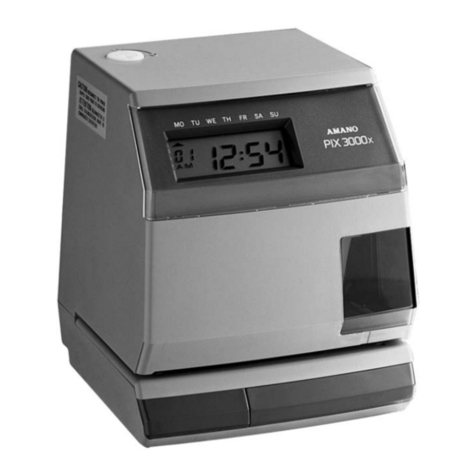
Amano
Amano PIX-3000x Series Operation manual
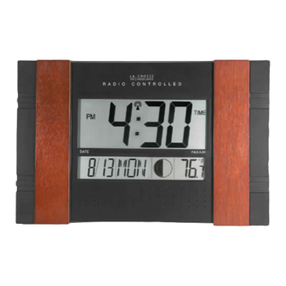
La Crosse Technology
La Crosse Technology WS-8001U instruction manual
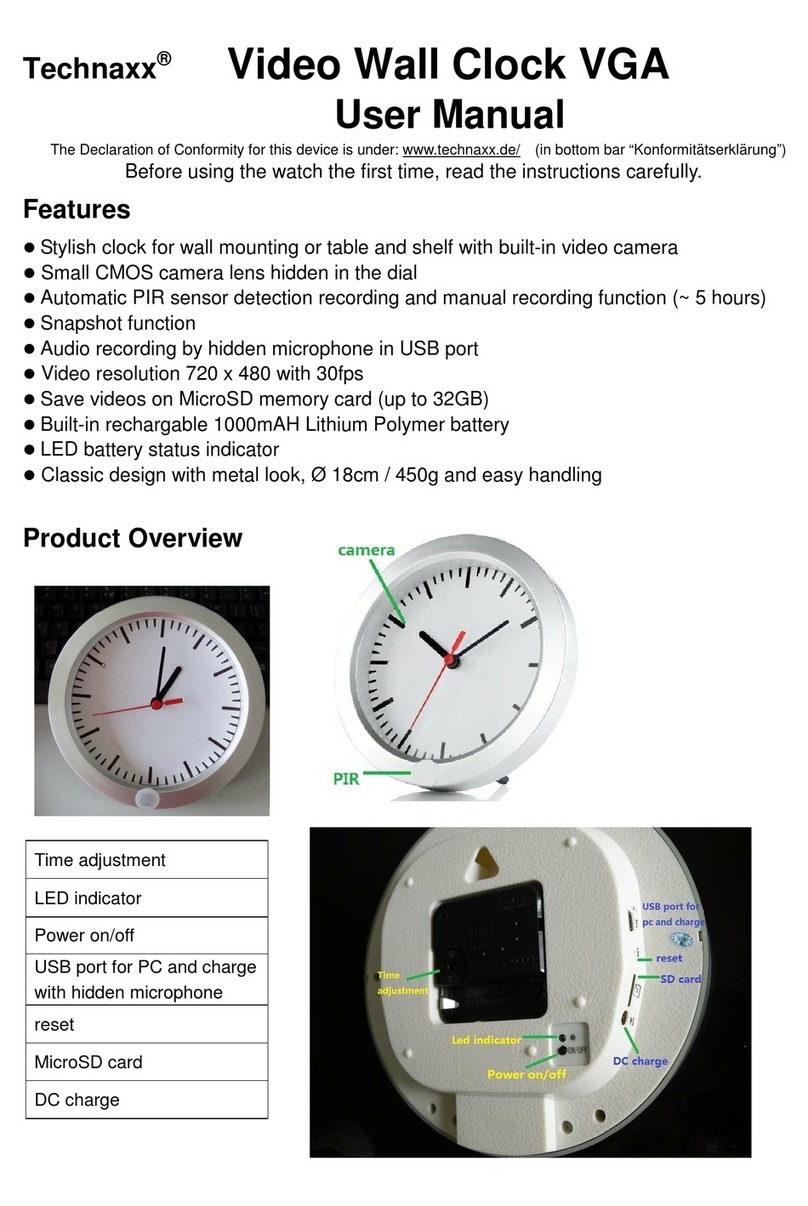
Technaxx
Technaxx 4219 user manual
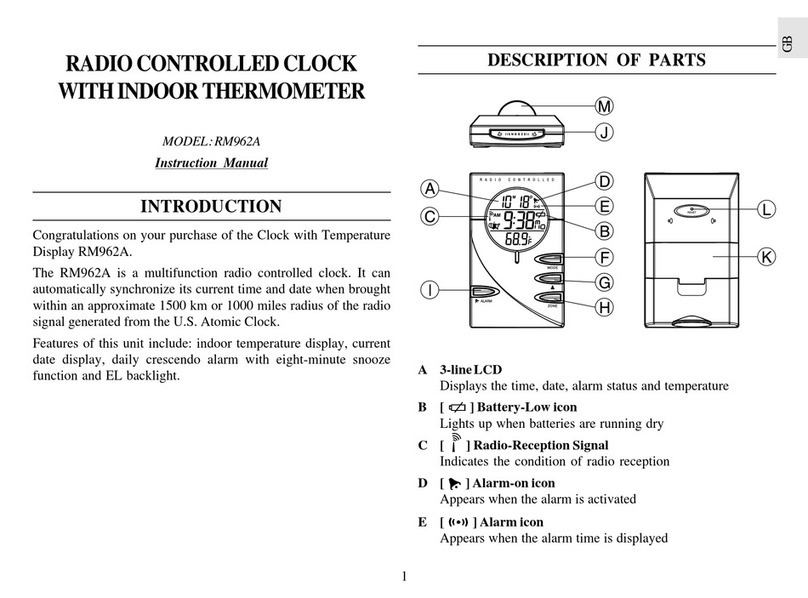
Oregon Scientific
Oregon Scientific RM962A instruction manual
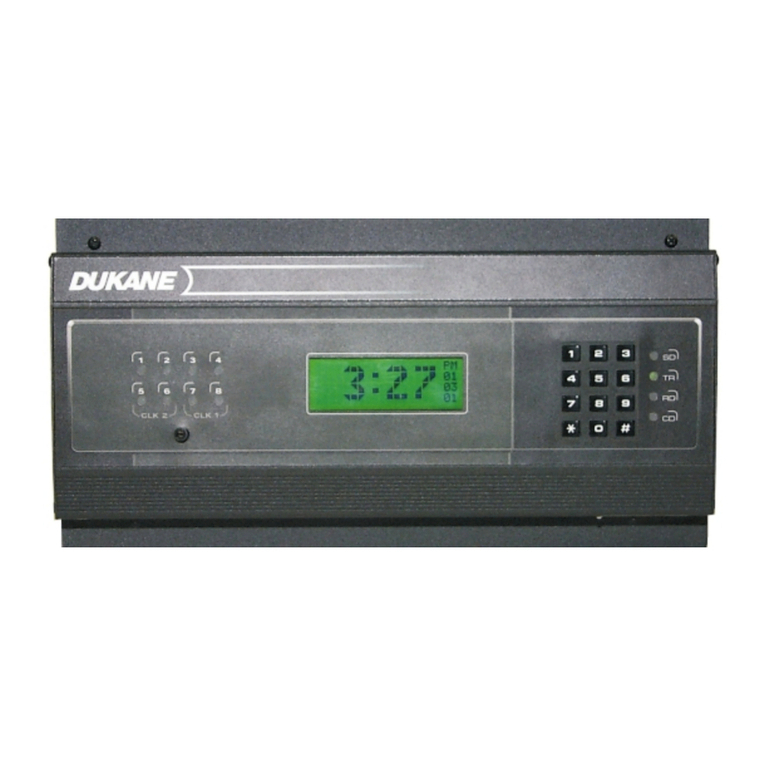
Dukane
Dukane Dukane 24A715M installation manual
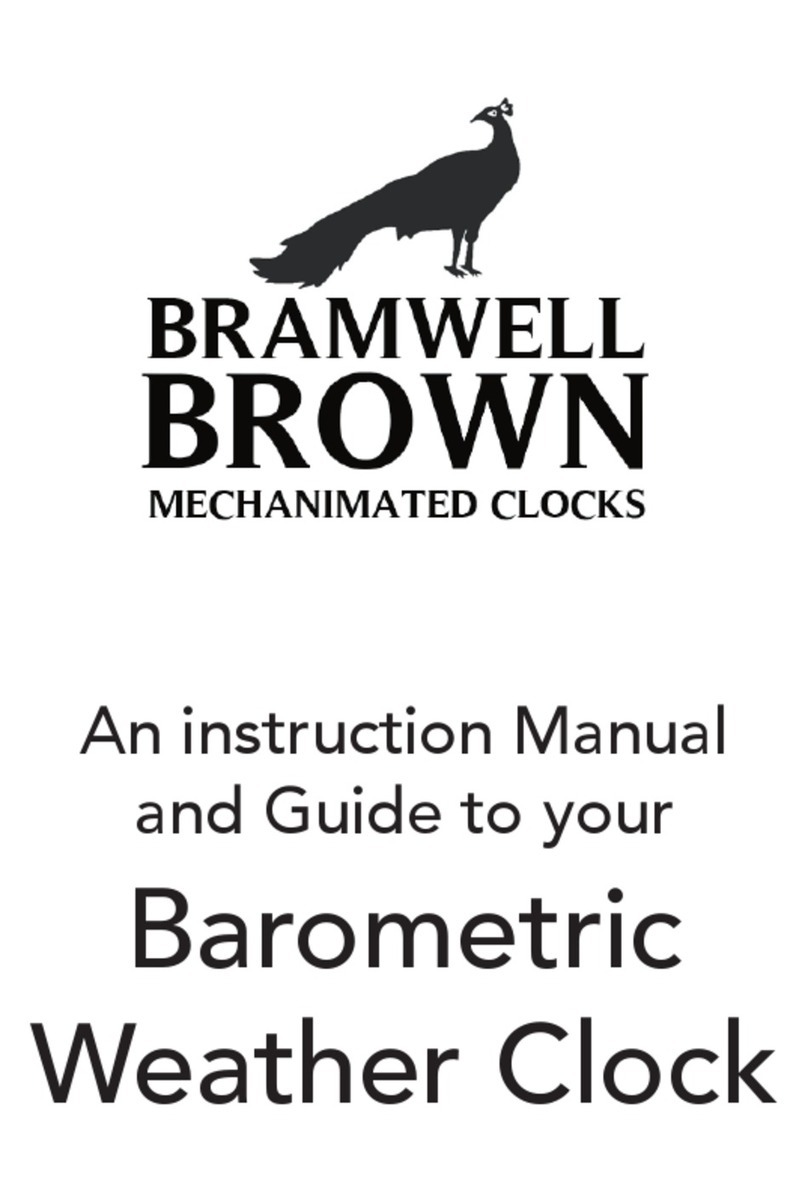
Bramwell Brown
Bramwell Brown Barometric Weather Clock Instruction Manual and Guide
